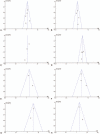Prognostic value of lymphocyte-to-monocyte ratio in ovarian cancer: A meta-analysis
- PMID: 31192919
- PMCID: PMC6587575
- DOI: 10.1097/MD.0000000000015876
Prognostic value of lymphocyte-to-monocyte ratio in ovarian cancer: A meta-analysis
Abstract
Background: Lymphocyte-to-monocyte ratio (LMR) was recently proposed as a prognostic factor of ovarian cancer. However, prognostic value of the LMR in ovarian cancer remains inconclusive. The study aimed to assess prognostic value of the LMR in ovarian cancer.
Methods: Seven common databases were comprehensively searched for relevant studies. The analyses were performed for overall survival (OS), progression-free survival (PFS) and clinical parameters. The hazard ratio (HR) and 95% confidence interval (CI) were used to analyze OS and PFS.
Results: A total of 2343 patients with ovarian cancer were included in this meta-analysis. The results showed that a low LMR predicted shorter OS (HR = 1.81, 95% CI = 1.38-2.37, P < .01) and PFS (HR = 1.65 95% CI = 1.46-1.85, P < .01) when compared to a high LMR in ovarian cancer. Besides, a low LMR was significantly associated with advanced clinical stage (P < .01), earlier lymph node metastasis (P = .01), higher carbohydrate antigen-125 levels (P < .01), larger residual tumor (P < .01) and worse chemosensitivity (P < .01) when compared to a high LMR in ovarian cancer.
Conclusion: Low LMR was associated with unfavorable survival in patients with ovarian cancer. LMR could serve as a prognostic biomarker of ovarian cancer.
Conflict of interest statement
The authors declare that they have no competing interests.
Figures




Similar articles
-
[The relationship of preoperativelymphocyte-monocyte ratio and the clinicopathological characteristics and prognosis of patients with epithelial ovarian cancer].Zhonghua Zhong Liu Za Zhi. 2017 Sep 23;39(9):676-680. doi: 10.3760/cma.j.issn.0253-3766.2017.09.007. Zhonghua Zhong Liu Za Zhi. 2017. PMID: 28926896 Chinese.
-
Prognostic value of lymphocyte-to-monocyte ratio in ovarian cancer: a meta-analysis.J Ovarian Res. 2019 May 31;12(1):51. doi: 10.1186/s13048-019-0527-z. J Ovarian Res. 2019. PMID: 31151469 Free PMC article. Review.
-
Clinicopathological and prognostic significance of lymphocyte to monocyte ratio in patients with gastric cancer: A meta-analysis.Int J Surg. 2018 Feb;50:67-71. doi: 10.1016/j.ijsu.2018.01.002. Epub 2018 Jan 9. Int J Surg. 2018. PMID: 29329786 Review.
-
Prognostic value of lymphocyte-monocyte ratio at diagnosis in Hodgkin lymphoma: a meta-analysis.BMC Cancer. 2019 Apr 11;19(1):338. doi: 10.1186/s12885-019-5552-1. BMC Cancer. 2019. PMID: 30971203 Free PMC article.
-
Prognostic Value of Pretreatment Lymphocyte-to-Monocyte Ratio in Lung Cancer: A Systematic Review and Meta-Analysis.Technol Cancer Res Treat. 2021 Jan-Dec;20:1533033820983085. doi: 10.1177/1533033820983085. Technol Cancer Res Treat. 2021. PMID: 33576324 Free PMC article.
Cited by
-
Role of Systemic Inflammatory Reaction in Female Genital Organ Malignancies - State of the Art.Cancer Manag Res. 2021 Jul 9;13:5491-5508. doi: 10.2147/CMAR.S312828. eCollection 2021. Cancer Manag Res. 2021. PMID: 34276227 Free PMC article. Review.
-
Recovery of the Decreased Phagocytic Function of Peripheral Monocytes and Neutrophil Granulocytes following Cytoreductive Surgery in Advanced Stage Epithelial Ovarian Cancer.Medicina (Kaunas). 2023 Sep 5;59(9):1602. doi: 10.3390/medicina59091602. Medicina (Kaunas). 2023. PMID: 37763721 Free PMC article.
-
Inflammation and Immune Escape in Ovarian Cancer: Pathways and Therapeutic Opportunities.J Inflamm Res. 2025 Jan 21;18:895-909. doi: 10.2147/JIR.S503479. eCollection 2025. J Inflamm Res. 2025. PMID: 39867950 Free PMC article. Review.
-
Predicting Chemotherapy Resistance in Gestational Trophoblastic Neoplasia: Ratio of Neutrophils, Lymphocytes, Monocytes, and Platelets.Med Sci Monit. 2022 Dec 8;28:e938499. doi: 10.12659/MSM.938499. Med Sci Monit. 2022. PMID: 36477073 Free PMC article.
-
Driving Immune Responses in the Ovarian Tumor Microenvironment.Front Oncol. 2021 Jan 15;10:604084. doi: 10.3389/fonc.2020.604084. eCollection 2020. Front Oncol. 2021. PMID: 33520713 Free PMC article. Review.
References
-
- Siegel RL, Miller KD, Jemal A. Cancer statistics, 2017. CA Cancer J Clin 2017;67:7–30. - PubMed
-
- Rooth C. Ovarian cancer: risk factors, treatment and management. Br J Nurs 2013;22:S23–30. - PubMed
-
- Davidson B, Trope CG. Ovarian cancer: diagnostic, biological and prognostic aspects. Womens Health (Lond) 2014;10:519–33. - PubMed
-
- Raja FA, Chopra N, Ledermann JA. Optimal first-line treatment in ovarian cancer. Ann Oncol 2012;23Suppl 10:x118–27. - PubMed
-
- Cannistra SA. Cancer of the ovary. N Engl J Med 2004;351:2519–29. - PubMed
Publication types
MeSH terms
LinkOut - more resources
Full Text Sources
Medical

